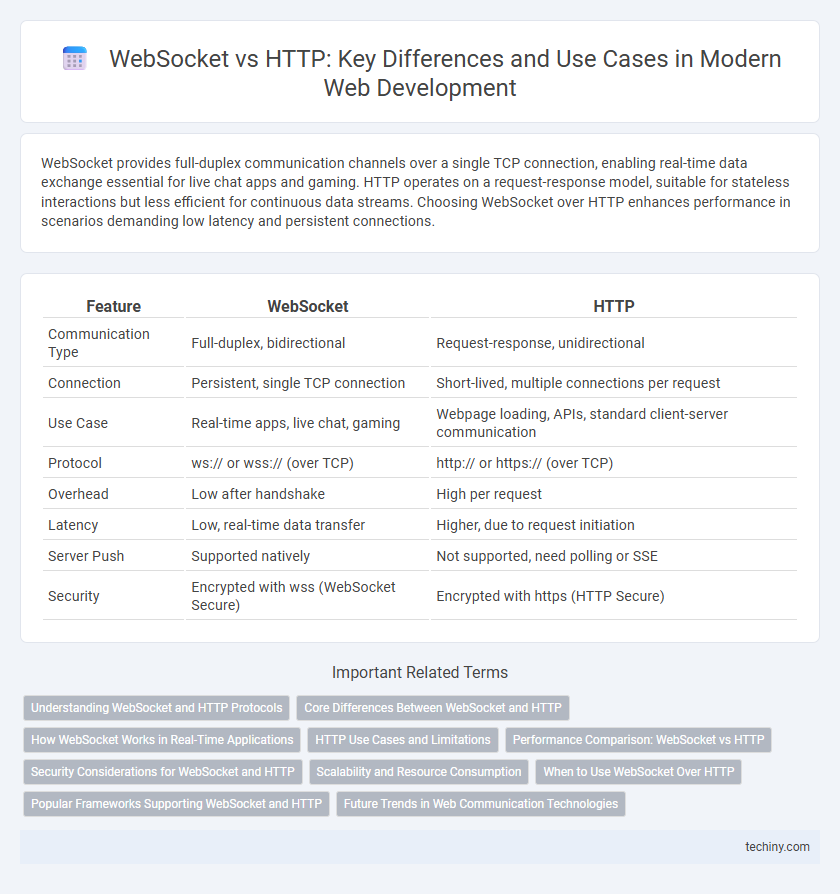WebSocket provides full-duplex communication channels over a single TCP connection, enabling real-time data exchange essential for live chat apps and gaming. HTTP operates on a request-response model, suitable for stateless interactions but less efficient for continuous data streams. Choosing WebSocket over HTTP enhances performance in scenarios demanding low latency and persistent connections.
Table of Comparison
| Feature | WebSocket | HTTP |
|---|---|---|
| Communication Type | Full-duplex, bidirectional | Request-response, unidirectional |
| Connection | Persistent, single TCP connection | Short-lived, multiple connections per request |
| Use Case | Real-time apps, live chat, gaming | Webpage loading, APIs, standard client-server communication |
| Protocol | ws:// or wss:// (over TCP) | http:// or https:// (over TCP) |
| Overhead | Low after handshake | High per request |
| Latency | Low, real-time data transfer | Higher, due to request initiation |
| Server Push | Supported natively | Not supported, need polling or SSE |
| Security | Encrypted with wss (WebSocket Secure) | Encrypted with https (HTTP Secure) |
Understanding WebSocket and HTTP Protocols
WebSocket is a communication protocol providing full-duplex channels over a single TCP connection, enabling real-time data exchange between client and server with low latency. HTTP is a stateless request-response protocol designed for transferring hypertext documents where each request opens a new connection, causing higher overhead for continuous communication. Understanding the persistent connection of WebSocket and the stateless nature of HTTP helps developers choose the most efficient protocol for interactive web applications requiring instant updates.
Core Differences Between WebSocket and HTTP
WebSocket establishes a persistent, full-duplex communication channel between client and server, enabling real-time data exchange with low latency, whereas HTTP operates on a request-response model that opens and closes connections for each interaction. WebSocket uses a single TCP connection to facilitate continuous, bidirectional data streams, while HTTP relies on multiple stateless connections, leading to higher overhead and latency. WebSocket is ideal for applications requiring instant updates, such as live chat or online gaming, whereas HTTP suits traditional web page retrieval and stateless services.
How WebSocket Works in Real-Time Applications
WebSocket enables real-time communication by establishing a persistent, full-duplex connection between the client and server, allowing data to be transmitted instantly without the overhead of repeated HTTP requests. This protocol maintains an open channel, facilitating low-latency updates and bidirectional data exchange critical for applications like live chat, online gaming, and financial tickers. Unlike HTTP's request-response model, WebSocket's continuous connection reduces network traffic and improves responsiveness, enhancing user experience in dynamic web environments.
HTTP Use Cases and Limitations
HTTP is ideal for traditional request-response communication in web applications, such as loading web pages, submitting forms, and RESTful API interactions, where statelessness and caching improve performance. Limitations arise in real-time applications because HTTP requires repeated client polling to receive updates, causing latency and increased server load. This makes HTTP less efficient for scenarios needing persistent, low-latency connections like live chat, gaming, or financial tickers.
Performance Comparison: WebSocket vs HTTP
WebSocket offers significantly lower latency and higher efficiency compared to HTTP by maintaining a persistent connection that eliminates the overhead of repeated HTTP handshakes. This persistent bi-directional communication enables real-time data transfer, making WebSocket ideal for applications requiring instantaneous updates, such as live chats and online gaming. In contrast, HTTP relies on a request-response model with higher latency and greater resource consumption due to frequent connection setups and headers exchange.
Security Considerations for WebSocket and HTTP
WebSocket connections use the ws:// or wss:// protocols, with wss:// providing encryption through TLS, similar to HTTPS, enhancing data confidentiality and integrity during real-time communication. HTTP relies on stateless request-response cycles and benefits from mature security practices like HTTP Strict Transport Security (HSTS) and widespread support for TLS encryption, making it suitable for secure, transactional data exchange. Developers must consider the persistent nature of WebSocket connections, potential vulnerabilities in message handling, and implement strict origin checks, authentication, and validation to mitigate risks such as cross-site WebSocket hijacking and man-in-the-middle attacks.
Scalability and Resource Consumption
WebSocket enables persistent, full-duplex communication channels between client and server, significantly reducing resource consumption compared to HTTP's request-response model by eliminating the overhead of opening and closing connections repeatedly. Scalability improves with WebSocket as servers manage fewer connection handshakes and lower latency, allowing efficient handling of high-frequency, real-time data streams for numerous concurrent users. In contrast, HTTP scales less effectively under heavy load due to its stateless nature and continuous resource locking for each HTTP request, leading to increased CPU and memory usage.
When to Use WebSocket Over HTTP
WebSocket is ideal for real-time, bidirectional communication scenarios such as live chat, online gaming, and financial tickers where low latency and continuous data exchange are crucial. HTTP remains suitable for traditional request-response tasks like accessing static web pages, submitting forms, and RESTful APIs that do not require persistent connections. Choosing WebSocket over HTTP depends on the need for persistent, full-duplex communication channels that reduce overhead and improve performance in interactive applications.
Popular Frameworks Supporting WebSocket and HTTP
Popular web development frameworks such as Node.js with libraries like Socket.IO and Express.js support both WebSocket and HTTP protocols, enabling real-time communication alongside traditional request-response cycles. Django Channels extends the Django framework to handle WebSocket connections efficiently, facilitating asynchronous features and live updates. ASP.NET Core's SignalR library simplifies adding WebSocket functionality, allowing seamless integration of real-time features within HTTP-based applications.
Future Trends in Web Communication Technologies
WebSocket is poised to become a cornerstone in real-time web communication due to its low-latency, full-duplex capabilities that HTTP cannot match. Emerging protocols like HTTP/3 and QUIC aim to enhance traditional HTTP performance but still lack WebSocket's persistent connection benefits for interactive applications. Future web communication trends will likely integrate WebSocket with evolving HTTP standards to support scalable, seamless user experiences in IoT, gaming, and live data streaming.
WebSocket vs HTTP Infographic

 techiny.com
techiny.com